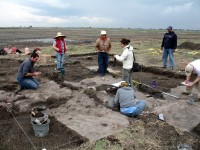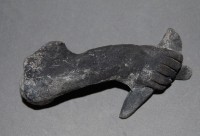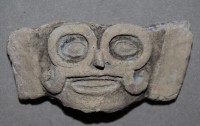 In winter of 2007, Dr. Christopher Morehart, assistant professor of anthropology at Georgia State University, was examining the dry bed of the former Lake Xaltocan as part of project on pre-Hispanic chinampa agriculture (a method that used small rectangular islands in shallow lakes to grow crops). The team first surveyed the area remotely with likely chinampas identified on satellite imagery and aerial photos. They then walked the site to collect samples and select places for further excavation only to find that looters had beaten them to the punch. The ground was disturbed and artifacts and bones scattered around. Moreheart realized that these remains had ritual significance, that they weren’t just the evidence of habitation.
In winter of 2007, Dr. Christopher Morehart, assistant professor of anthropology at Georgia State University, was examining the dry bed of the former Lake Xaltocan as part of project on pre-Hispanic chinampa agriculture (a method that used small rectangular islands in shallow lakes to grow crops). The team first surveyed the area remotely with likely chinampas identified on satellite imagery and aerial photos. They then walked the site to collect samples and select places for further excavation only to find that looters had beaten them to the punch. The ground was disturbed and artifacts and bones scattered around. Moreheart realized that these remains had ritual significance, that they weren’t just the evidence of habitation.
The excavations that followed unearthed 31 skulls many of them discovered in lines facing east. Artifacts found included seashell pendants, greenstone beads, figurines of deities, ceramic effigies, obsidian knives, corn cobs and chile peppers, some of which were parts of incense burners. Pollen from ritually significant flowers, like from the Tagetes genus which contains the cempoalxochitl marigold, a flower that as late as the 16th century was central Mexican rituals every month of the year, was discovered on the site. The remains of pine charcoal and burned maize cobs were also found. Pine wood was probably used as kindling for the braziers and also burned as incense or for ritual torches. The maize cobs could have been burned as offerings of food.
The burned organic material was radiocarbon dated pinpointing the date of the sacrifices to between 660 and 890 A.D., during or just after the collapse of Teotihuacan. The ceramic finds support the date range. This was a period known as the Epiclassic, between the fall of Teotihuacan and the rise of smaller city-states before the Aztec empire took them all over in the 15th century.
 A 2012 follow-up excavation funded by National Geographic revealed even more skulls; the numbers right now total between 150 and 200 skulls or cranial pieces making up skulls. Although large numbers of skulls deposited during ritual sacrifices have been found in pre-Hispanic temples, this is the first time a collection of sacrificial skulls has been found outside of a major religious structure in a city settlement. About 130 skulls have been assembled, cleaned and cataloged thus far. They all appear to be from adult males, some with artificial cranial deformation and incised teeth, some without. This heterogeneity is another unusual characteristic of the find.
A 2012 follow-up excavation funded by National Geographic revealed even more skulls; the numbers right now total between 150 and 200 skulls or cranial pieces making up skulls. Although large numbers of skulls deposited during ritual sacrifices have been found in pre-Hispanic temples, this is the first time a collection of sacrificial skulls has been found outside of a major religious structure in a city settlement. About 130 skulls have been assembled, cleaned and cataloged thus far. They all appear to be from adult males, some with artificial cranial deformation and incised teeth, some without. This heterogeneity is another unusual characteristic of the find.
Then there were the fingers in the eyes. Some of the skulls were discovered with phalanges of the hand inserted into the eye sockets. According to Morehart, this was unlikely to be a coincidence or the result of disruption of the burials by looters or animals. The fingers were found in enough eye sockets that they had to have been deliberately placed there for an unknown ritual purpose.
The area itself was a raised platform, a shrine constructed in the shallow lake by building up three feet of chalky material like crushed limestone. It’s highly uncharacteristic of Mesoamerican platform shrines in that it has no facing stones, adobe bricks or masonry elements. It’s also in the middle of nowhere, relatively speaking, about 10 miles from the pre-Aztec city-state of Teotihuacan. Yet, if the numbers hold up, this minor bump on the landscape in the middle of a farming community may be one of the largest mass sacrifice sites ever discovered.
 Its rural location and agricultural surroundings may explain the nature of the shrine. Carvings of Tlaloc, god of rain and water, the sacrifice of maize, the ceramic maize cobs and chiles suggest the sacrifices were in aid of local farming. On the other hand, human sacrifice in Mesoamerica was usually linked to warfare and the expression of state power. Perhaps the uncertainty and chaos in the wake of the decline of the great regional power and the long period of drought that kept lake waters low drove rural peoples to devise new rituals.
Its rural location and agricultural surroundings may explain the nature of the shrine. Carvings of Tlaloc, god of rain and water, the sacrifice of maize, the ceramic maize cobs and chiles suggest the sacrifices were in aid of local farming. On the other hand, human sacrifice in Mesoamerica was usually linked to warfare and the expression of state power. Perhaps the uncertainty and chaos in the wake of the decline of the great regional power and the long period of drought that kept lake waters low drove rural peoples to devise new rituals.
Arizona State University Dr. Michael E. Smith, who was not involved in the project, said “this is certainly an impressive and very puzzling find,” adding, “I am not aware of any other finds of mass burials or mass sacrifices outside of major settlements.” […]
Smith said it is possible that, as archaeologists start excavating more ancient farm sites, they might discover more evidence of large-scale rural sacrifices. “Very few rural areas or rural shrines have ever been located, so it is hard to say that this site represents an unusual find. It certainly is unusual for being the first such feature excavated by archaeologists, but it is possible that such shrines were more common in ancient times; we simply have no idea.”
Pictures of the skulls have not been officially released out of respect for the current inhabitants of the region, but you can see some small black and white images of them in the paper published on the 2007 excavation.